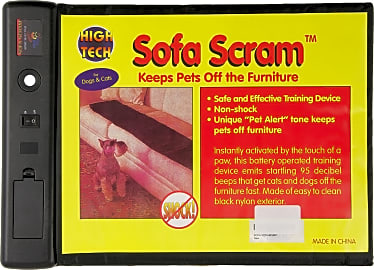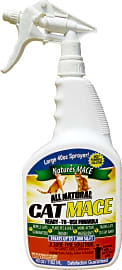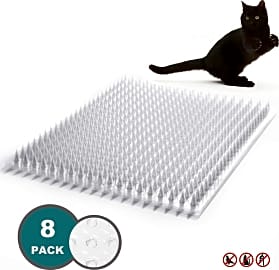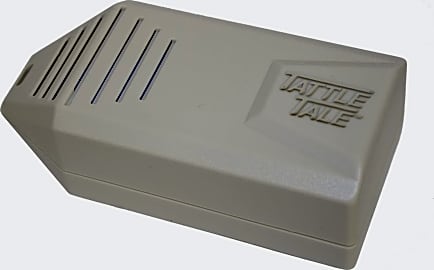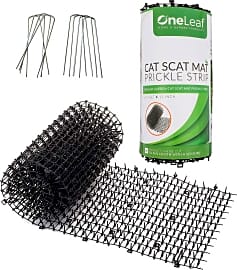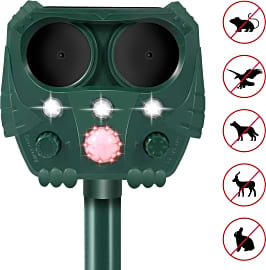The 10 Best Cat Repellents

This wiki has been updated 38 times since it was first published in June of 2015. If you need a deterrent to keep unwanted cats out of your garden or away from certain areas inside your home, one of the repellents on our list will have them heading in the other direction in no time at all. Since not all animals are receptive to the same type of correction, we have included a variety of options, from those that rely on scent or sound to physical barriers. When users buy our independently chosen editorial recommendations, we may earn commissions to help fund the Wiki.
Editor's Notes
August 20, 2020:
Whether for an indoor pet our an outdoor animal, there are many reasons you may want to keep felines out of certain areas, and these cat repellents are just the way to do it. Since not all kitties respond to corrective measures the same, we made sure to include a variety of deterrents that rely on different methods.
For those who are dealing with animals that are sensitive to sound, a noise-based or ultrasonic option should work well. In this category, we have the Amtek Scraminal, Sofa Scram, Tattle Tale Alarm for indoor use, all of which create a loud beep that is also audible to human ears. For outdoor use, we have the Petbroo Ultrasonic, which, as the name implies, should be essentially noiseless to humans, but not so to felines. It also utilizes flashing lights, which can be great for startling animals at night.
The PetSafe Indoor Radio Fence utilizes a combination of sound and static feedback to stop animals in their tracks, though it does require the separate purchase of a compatible collar from the same company, as it doesn't produce any corrections by itself.
A scent-based option like Nature's Mace Cat can be useful for felines that don't respond to high-pitched tones, and it can safely be used in the home or outside around the property. Since its active ingredients are just peppermint, lemongrass, and citronella oils, it isn't harmful to the animal or children.
If neither scent nor sound has proven effective for you, it may be best to resort something that is physically uncomfortable for a cat. There is no chance that Orbit 62100 Yard Enforcer, which is a motion-activated sprinkler, won't be annoying enough to send them off your property, or at least out of its range. Of course, if you need something for inside a home, it won't be a suitable option. In this case, we recommend the PetSafe Ssscat, which is essentially just a small spray bottle, but it, too, is motion-activated, so you won't have to be around to manually squeeze the trigger. The Homarden Garden Scat Mat and Zipcase Outdoor Mat are spiked floor or wall coverings that kitties will find uncomfortable to walk on, and they can be used inside or outside the home.
April 22, 2019:
Anybody who has ever owned a cat, or even simply spent some time at someone's house who does, knows how stubborn they can be, which is why it is so hard to keep them away from areas they choose to frequent. Luckily, these feline repellents can help. If you need something for outdoor use to keep stray cats away from your yard, take a look at the Royalsell Stake, PredatorGuard PestAway, Hoont Motion Activated, Nature's Mace, Natural Armor Spray, or Homarden Garden Cat Scat Mat. The first three are all ultrasonic models that emit a sound cats find rather unpleasant, but is generally inaudible to humans. Nature's Mace and Natural Armor Spray are both scent-based options that you simply squirt on plants, around doorways, or any other areas, while the Homarden Garden Cat Scat Mat is literally a physical barrier the felines find uncomfortable to walk on. For indoor use, we have included the Amtek Scraminal, Sofa Scram, Tattle Tale Sonic Pet Training Alarm, and PetSafe Ssscat.
Special Honors
Epic Professional Cat Repellent If you want to cover a large property, an 8-pound bucket of Epic Professional Cat Repellent should be up to the task. You can sprinkle the granules liberally everywhere you want to keep felines away from, and it is made with natural, organic ingredients, so it won't be harmful to them or the environment. animaltrapsandsupplies.com
A Brief History Of The Common Cat
Horses were not domesticated for almost another 10,000 years, for reference.
Human beings began the process of domesticating dogs approximately 15,000 years ago. The animal that would come to be known broadly as canis lupus familiaris is the oldest known example of a creature intentionally domesticated by mankind. Horses were not domesticated for almost another 10,000 years, for reference.
Anyone who has ever owned or is otherwise intimately familiar with cats, on the other hand, will not be the least bit surprised to know that cats were never fully domesticated by humans. Rather, cats chose to domesticate themselves. Those who know cats well will tell you that ironic quotation marks around the word "domesticate" may be necessary when it comes to discussing this decidedly odd animal that we now call felis catus.
Cats descended from a member of the broader felis genus known as the African Wildcat, an animal that remains not only extant but has a Least Concern status in the conservation community. Ostensibly, domestic cats first appear in Egyptian arts and artifacts dating back some 4,000 years, though other archeological evidence points to potential domestic human-cat existence several thousand years before this in areas as divergent as Cyprus and China.
Cats came to be revered in many cultures, including Ancient Egypt, by many early Muslims, and even by many Norseman -- the goddess Freyja, namesake of the weekday Friday, was often depicted riding in a chariot drawn by cats. While domestic house cats remain wildly popular as pets and as cultural memes in the modern world, feral cats can cause myriad issues. Cats are excellent hunters, killing as many as three billion or more birds and as many as 20 billion mammals annually in the United States alone. These figures seem staggering until one realizes that there are an estimated 80 million feral cats prowling the alleys, forests, and suburbs of America.
Not only are stray and feral cats a threat to wildlife, but they can be both a nuisance and a hazard for humans as well, overturning trash cans and spreading garbage, making noise while yowling or fighting, spreading certain diseases and parasites, and even attacking people, with children at particular risk.
Fortunately, while humans may never be able to fully master and domesticate this unique creature, we do have many ways of deterring cats from entering our property by using cat repellents.
The Olfactory Approach To Cat Repelling
There are two primary types of scent-based cat repellent formulas, and they can be broadly referred to as the pepper approach, or the citrus approach.
There are two primary types of scent-based cat repellent formulas, and they can be broadly referred to as the pepper approach, or the citrus approach.
Many cat repellents use ingredients derived from black and red peppers, especially the powerful natural compound capsaicin, which is found on some of the hottest chili peppers. While enjoyable (for some humans) in foods in smaller amounts, capsaicin is a powerful irritant in higher doses such as those found in repellents, and can bother both the nasal passages and mouths of animals that come into contact with it so acutely that they will not only flee, but will potentiality never return to the source of their discomfort.
These repellents are usually found in pellet or granular form, perfect for creating a barrier line around your yard, garden, or other areas of your property. (These repellents are also effective for other animals, like skunks and raccoons.)
Citrus based cat repellents are usually found in liquid form, and are perfect for mixing in with the soil of a flower bed or garden that unwanted cats are using as a litter box or where they stalk harmless prey. Citrus repellents are a good choice for use around humans -- especially children -- as they are not nearly as irritating as pepper-based formulas should they come into contact with a person.
The Technological Take On Cat Repellents
Aside from the "biological warfare" take on repelling stray and feral cats, many devices exist that are capable or scaring away feline pests though the use of sound, light, or both. These units feature infrared detectors that will trigger ultrasonic noise when an animal draws near. The sounds they emit are too high in frequency for a human to hear, yet are unbearable for an animal, and apt to send them scurrying from your property.
You might want to consider a unit with a strobe light that can be turned off at night, however.
Add in the bright, flashing strobe light that most units feature and you will equip your property with a two-pronged approach to keeping cats away. Note that while at first blush you might think that the longer the detection range of a unit, the better, in fact a cat repellent with a range of only twenty five feet or so may be better than one that "watches" an area reaching out much farther. If your yard is small, there is no need to also be patrolling the neighbors yard, for example, especially if they have dogs or cats (or kids) that are allowed outside.
You might want to consider a unit with a strobe light that can be turned off at night, however. While it might seem ironic to switch a light off after darkness, a time when it might be most effective, you have to balance the two-pronged approach (sound and light, e.g.) to repelling cats against interfering with your own sleep and/or the comfort of your human neighbors. The light will still be effective during the dusk and into the evening, and you can simply switch it off before bedtime.
And, as with the scent-based repellents, note that these units also work well at keeping away other animals.


